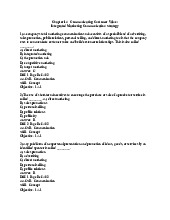






Preview text:
THE INTERNATIONAL UNIVERSITY (IU) – VIETNAM NATIONAL UNIVERSITY – HCMC MID-TERM EXAMINATION Date: November 2016 Duration: 90 minutes
Student ID: ..................................
Name:................................................
SUBJECT: Principles of Marketing
Dean of School of Business Lecturers : Administration Signature: Signature:
Full name: Dr. Nguyen Van Phuong
Full name: Dr. Ho Thi Bich Van Dr. Nguyen Hong Anh Ms. Nguyen Que Tien Mr. Nguyen Tran Nguyen Khai INSTRUCTIONS:
1. This is an open book examination WITH ONLY TEXTBOOK AND LECTURE NOTES 2. No talking during exam
3. No mobile phone, tablet use during the exam.
4. The students can use dictionary IN HARD COPY ONLY GOOD LUCK!
Part A: Multiple-Choice Questions (60 points, students answer MC questions on this question paper)
1. Which of the following is the aim of the product concept?
A. improve the marketing of a firm's best products
B. focus on the target market and make products that meet those customers' demands
C. focus on making continuous product improvements
D. ensure that product promotion has the highest priority
E. market only those products with high customer appeal
2. Which of the following terms refers to sellers being preoccupied with their own products
and with consumers’ existing wants? A. social loafing B. vendor lock-in 1 C. conspicuous consumption D. marketing myopia E. value proposition
3. It is most accurate to say that when customers purchase products they act on
________as they judge values and costs. A. objective value B. perceived value C. company image D. customer lifetime value E. society's interests
4. Through ________, companies today are strengthening their connections with all
partners, from providers of raw materials and components to those involved in the
delivery of final goods and services.
A. customer relationship marketing B. customized marketing C. inventory management
D. supply chain management E. direct marketing
5. Apart from retaining good customers, most marketers want to constantly increase their
"share of customer." What does this mean in marketing terms?
A. Marketers want to increase the share they get of the customer's purchasing in
their product categories.
B. Marketers want to turn satisfied customers into delighted customers.
C. Marketers want to diversify their operations and customize their products to cater to the entire market.
D. Marketers want to increase their market share.
E. Marketers want to continuously increase their customers' levels of satisfaction.
6. As part of the rapid globalization of today's economy, companies are selling more
domestically produced goods in international markets and ________.
A. competing solely in traditional marketplaces
B. downplaying concerns for social responsibility
C. purchasing more supplies abroad
D. taking a local view of their industry
E. reducing competition within their industry
7. Nam has been directed to study the actors close to a company that affect its ability to
serve its customers, such as the company, suppliers, marketing intermediaries,
customer markets, competitors, and publics. In this instance, Nam has been directed to
study the ________ of the company. A. political environment B. technological environment C. demographic environment D. macroenvironment E. microenvironment
8. Maria works for WPP Group, a firm that helps companies target and promote their
products to the right markets. Sigma is most likely a ________. A. physical distribution firm B. marketing services agency C. reseller D. financial intermediary 2 E. wholesaler
9. ________ markets buy goods and services for further processing. A. Reseller B. Consumer C. Wholesale D. Business E. Retail
10.Wholesome Soups, a maker of organic soups, is starting a new marketing campaign
emphasizing the ease of preparing and eating Wholesome Soups. Print, television, and
Internet ads feature teens enjoying Wholesome Soups in between classes and during
study breaks. Wholesome Soups' new marketing campaign is most likely aimed at which of the following? A. Millennials B. Gen Xers C. Baby Boomers D. the SOHO market E. the LOHAS market
11.Which of the following demographic trends is the most likely cause for a rapid increase in telecommuting?
A. the migration toward micropolitan and suburban areas
B. the growing percentage of married couples who do not have children
C. the declining number of manufacturing workers in today's workforce
D. the migration from rural to metropolitan areas
E. the increasing number of traditional households
12. Rather than assuming that strategic options are bounded by the current environment, firms adopting a(n)
________ to the marketing environment develop strategies to change the environment. A. reactive stance B. relativist approach C. environmental stance
D. no-compromise approach E. proactive stance
13.An MIS is used to ________. A. generate product interest
B. assess information needs
C. test hypotheses about cause-and-effect relationships
D. identify demographic trends E. develop marketing plans
14.Which of the following refers to a marketing intelligence technique?
A. benchmarking competitors' products
B. implementing product diversification
C. investing heavily on primary research
D. interviewing customers randomly
E. increasing the annual budget for R&D
15.Which of the following is the objective of causal research?
A. to assign a cause to a seemingly random event
B. to test hypotheses about cause-and-effect relationships
C. to describe things, such as the market potential for a product
D. to gather preliminary information that will help suggest hypotheses 3
E. to predict the effect of a random event on unrelated entities
16.________ involves gathering primary data by closely examining relevant people, actions, and situations. A. Survey research B. Group interviewing
C. Observational research D. Telephone interviewing E. Causal research
17.Which of the following is most likely an advantage of survey research?
A. The data gathered in survey research is impartial and free from bias as the surveys
are done in-person to evaluate consumer behavior.
B. The chances of getting dishonest feedback are almost negligible with survey research.
C. Survey research allows researchers to observe respondents closely in their natural environments.
D. The attitudes and motives of the customers can be easily determined through survey research.
E. The flexibility of survey research is high; it can be used to obtain many
different kinds of information in many different situations.
18.Which of the following questions is an example of a closed-end question?
A. How can I improve my presentation skills?
B. Why do you think a single vote makes a difference?
C. Why do you think some people are more comfortable taking risks than others?
D. Would you like to try our new ice cream flavor?
E. What is the best way to prevent weeds in a garden?
19.________ are groups to which an individual wish to belong, as when a teenaged
football player hopes to play someday for the famous football club of Manchester United. A. Membership groups B. Aspirational groups C. Leading adopter groups D. Leisure groups
21. Researchers found that a number of well-known brands tended to be strongly
associated with one particular trait, such as Jeep with "ruggedness” or Apple
with “competent”. Which of the following terms would a marketer use to describe
a specific mix of human traits that may be attributed to a particular brand? A. brand perception B. product image C. brand personality D. brand concept
22. As a consumer, Trang always tends to interpret new information in a way that will
support what she already believes in. This behavior of Trang is called ________. A. selective retention B. selective distortion 4 C. selective attitude D. selective attention
23. The relationship between the consumer's expectations and the product's
________ determines whether the buyer is satisfied or dissatisfied with a purchase. A. perceived performance B. brand personality C. recognition D. consumer market
24. With dissonance- reducing buying behavior, consumers are highly involved with
an expensive, infrequent, or risky purchase, but see little difference among
brands. In these items below, which one is NOT a consumer behavior
associates with dissonance reducing buying behavior?
A.Consumers do intensive searching for information regarding the products/brands before making the purchase
B. Consumers are influenced by sales people while they make buying decision in store.
C. Post-purchase dissonance as consumers feel happy at first when they make
the buying decision, however after using the product, consumers now have the
tendency to regret that they should have bought the other products/ brands instead
D. Consumers passively receive information as they watch TV and make the buying
decision based on the products/ brands they remember the most from advertising repetition
25. Many companies, such as JetBlue and Sony, enlist everyday consumers who
are enthusiastic about their brands to become ________, brand
ambassadors who share their passion for a company's products with
large circles of friends and acquaintances in return for insider knowledge and other rewards. A.
leading adoptersB. brand evangelists C. direct marketers D. direct sellers
26. What are the business buyers' three types of buying situations? A. Awareness, evaluation, trial B.
Straight rebuys, rebuys for laggards, old task C.
Straight rebuys, modified rebuys, new task D. None of the above
26.Which of the following is one of the business roles in the purchase decision process? A. Gatekeeper B. Producer C. Retailer D. None of the above
27.Which of the following statements is true?
A. Most manufacturers make all or even a majority of their sales through direct channels
B. Compared with consumer purchases a business purchase involves more decision 5 participants
C. In the business buying process the buyer and seller are often much less dependent on each other D. None of the above
28.Which of the following is not a characteristic of business markets?
A. Business buyer demand is derived from final consumer demand
B. Demand in business markets fluctuates more, and more quickly
C. Business buyers usually face less complex buying decisions
D. The business buying process is more formalized
29.Supplier search is the first stage of the business buying process. True ( ) False ( )
30.Many business markets have Inelastic demand; the total demand for many business
products is not affected much by price changes, especially in the short run. True ( ) False ( )
Part B: Open Questions (40 points)
1. Compare the selling and marketing concepts, listing the key components of each philosophy.
Answer: Kotler and Armstrong (2014) Principles of Marketing, 15th Edition, pp.32-33
Figure 1.3 contrasts the selling concept and the marketing concept.
The selling concept reflects an inside-out perspective, while the marketing concept takes an
outside-in perspective. The selling concept is typically practiced when an organization is
marketing products or services that buyers do not normally think of purchasing, such as
insurance or blood donation. Aggressive selling focuses on creating sales transactions rather
than building long-term relationships with customers, with the aim of selling what the company
makes rather than making what the customer wants (product-centered make and sell
philosopy). The marketing concept, on the other hand, is based upon identifying the needs and
wants of target markets and then satisfying those needs and wants better than competitors do.
In contrast to the selling concept, marketing focuses on the customer, not the product, as the
path to profits (customer-centered sense and respond phylosophy).
2. Explain what is meant by systems selling and discuss why it is a preferred approach to
buying for many organizations?
Answer: Kotler and Armstrong (2014) Principles of Marketing, 15th Edition, pp. 193-194.
Many business buyers prefer to buy a complete solution to a problem from a single seller
rather than buying separate products and services from several suppliers and putting them
together. The sale often goes to the firm that provides the most complete system for meeting
the customer's needs and solving its problems. Such systems selling (or solutions selling) is
often a key business marketing strategy for winning and holding accounts. 6
As in many cases of system corporations, IBM and its customer Six Flags Entertainment
Corporation, IBM will work with Six Flags throughout the process. Thus, IBM isn’t just selling
the software, it’s selling a complete solution to Six Flags’s complex asset management problems. 7




